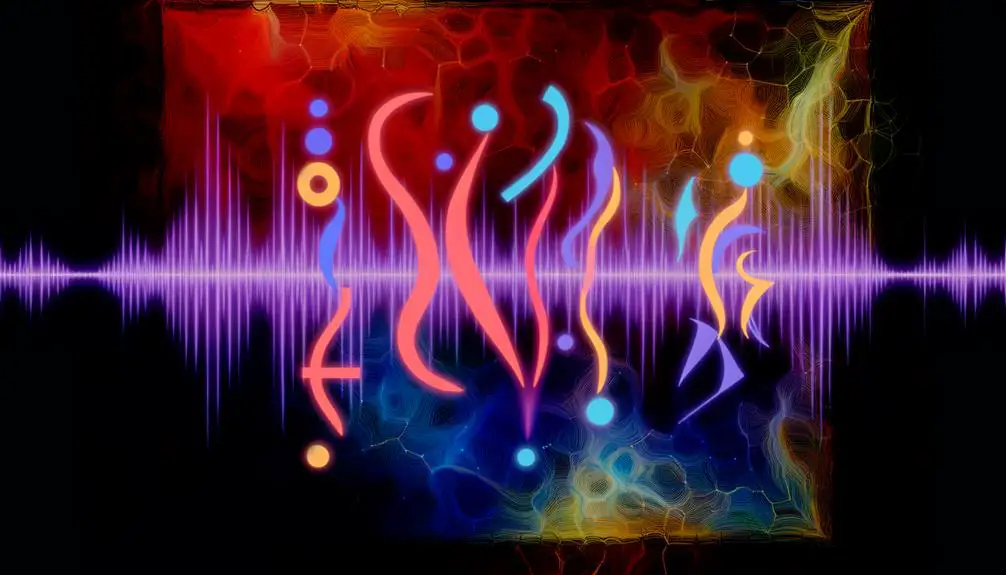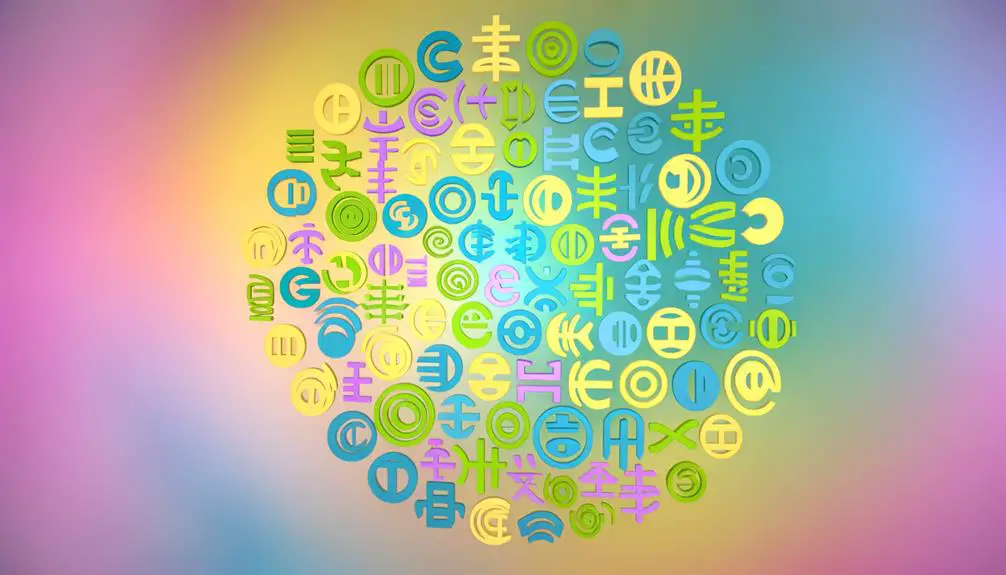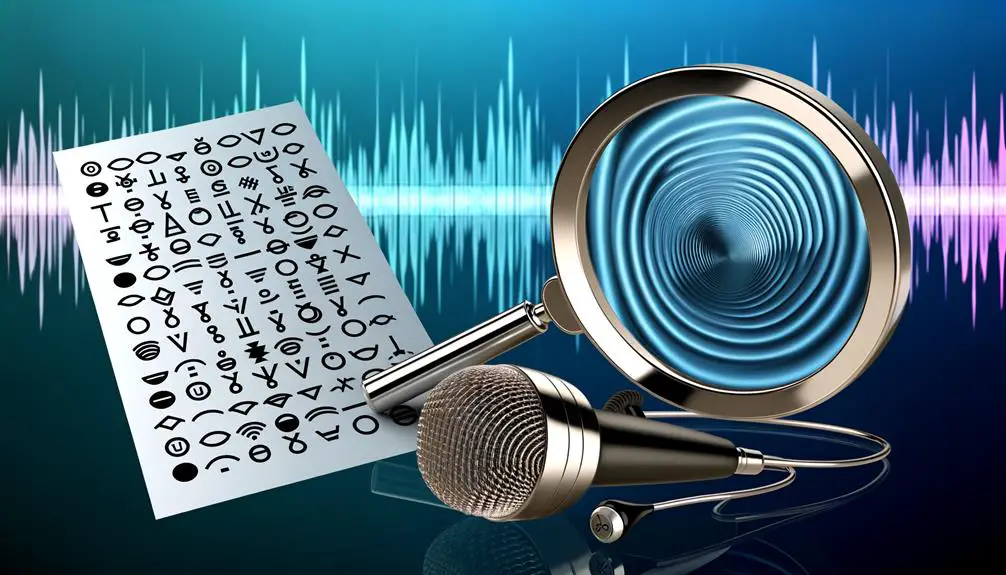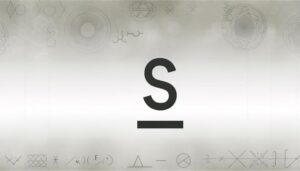How Phonetic Symbols Represent Speech Sounds
A symbol that represents a speech sound is known as a phonetic symbol. These symbols correspond to phonemes, the smallest units of sound in a language, and are used to capture and transcribe speech accurately.
The International Phonetic Alphabet (IPA), developed in the late 19th century, standardizes these symbols to represent all human speech sounds. The IPA's precise notations aid in linguistic analysis, language learning, and the development of speech recognition systems in AI.
Understanding the IPA and phonetic transcription techniques is essential for accurate linguistic representation and advanced technological applications. For an in-depth exploration, more awaits.

Key Takeaways
- Phonetic symbols represent speech sounds and are standardized by the International Phonetic Alphabet (IPA).
- Each IPA symbol corresponds to a specific phoneme, ensuring accurate representation of sounds.
- Phonetic symbols are used in transcription to detail pronunciation and phonetic nuances.
- Broad transcription captures essential elements, while narrow transcription includes finer phonetic details.
- Mastery of phonetic symbols is crucial for language learning and AI speech recognition development.
What Is a Phoneme?

A phoneme is the smallest unit of sound in a language that can distinguish one word from another.
For example, in English, the words 'bat' and 'pat' differ by a single phoneme /b/ and /p/.
Phonemes function as abstract mental representations of sound rather than physical sound instances, enabling speakers to perceive distinct meanings.
Linguists categorize phonemes based on articulatory and acoustic properties, such as voicing, place, and manner of articulation.
Voicing distinguishes phonemes like /z/ and /s/ by vocal cord vibration, while place of articulation involves tongue positioning, as seen in /t/ vs. /k/.
Analyzing phonemes assists in understanding language structure, phonological rules, and the development of orthographic systems.
History of Phonetic Symbols
The evolution of phonetic symbols traces back to early linguistic endeavors to systematically represent the sounds of spoken language.
Ancient scholars, such as the Sanskrit grammarians of India, pioneered the meticulous documentation of phonetic elements.
In the West, the development of the International Phonetic Alphabet (IPA) in the late 19th century marked a significant advancement, providing a standardized system for phonetic transcription.
The IPA, created by the International Phonetic Association, sought to encompass all human speech sounds using a consistent set of symbols.
This innovation facilitated cross-linguistic comparisons and advanced the fields of phonetics and linguistics.
Over time, the IPA has undergone refinements to address the intricacies of speech sounds, reflecting ongoing linguistic research and technological advancements.
Phonemes in Different Languages

Building on the foundation established by the International Phonetic Alphabet, the study of phonemes across different languages reveals significant variation in the inventory and function of speech sounds. Phonemes, as the smallest units of sound, differ greatly among languages regarding both quality and quantity. For instance, some languages utilize a minimal set of phonemes, while others employ a more extensive range. The table below illustrates the phonemic diversity in selected languages:
| Language | Vowel Phonemes | Consonant Phonemes |
|---|---|---|
| English | 20 | 24 |
| Japanese | 5 | 15 |
| Arabic | 8 | 28 |
| Spanish | 5 | 17 |
| Mandarin | 6 | 21 |
This variability underscores the complexity and richness of human speech, reflecting diverse phonetic architectures across linguistic landscapes.
The International Phonetic Alphabet
The International Phonetic Alphabet (IPA) provides a standardized system for representing speech sounds across different languages, thereby facilitating accurate and consistent phonetic transcription.
As a global linguistic tool, the IPA includes an extensive set of symbols that correspond to specific phonemes, ensuring clarity in linguistic analysis and communication.
This system's precision and universality make it indispensable for linguists, language learners, and speech pathologists.
Standardized Sound Representation
Created to provide a consistent and accurate method for representing the sounds of spoken language, the International Phonetic Alphabet (IPA) is an essential tool in the field of linguistics. By employing a standardized set of symbols, the IPA allows linguists, language teachers, and speech pathologists to transcribe speech sounds from any language with precision. Each symbol in the IPA corresponds to a specific phonetic sound, ensuring uniformity in phonetic transcription.
| Symbol | Sound Description | Example in English |
|---|---|---|
| [p] | Voiceless bilabial plosive | "pat" |
| [θ] | Voiceless dental fricative | "think" |
| [ʃ] | Voiceless postalveolar fricative | "she" |
| [ɹ] | Voiced alveolar approximant | "red" |
This systematic approach minimizes ambiguities and aids in the clear documentation and analysis of phonetic data.
Global Linguistic Tool
As a versatile tool for the accurate representation of speech sounds across diverse languages, the International Phonetic Alphabet (IPA) serves as a global standard in linguistic research and education. The IPA's utility is manifested through its all-inclusive system, which enables the precise transcription of any spoken language.
Key benefits of the IPA include:
- Universality: IPA symbols are recognized and used globally, facilitating cross-linguistic studies and comparative phonetic analysis.
- Clarity: Each symbol corresponds to a distinct sound, reducing ambiguity in phonetic transcription and enabling clearer communication among linguists.
- Educational Utility: The IPA is integral to teaching pronunciation, aiding language learners and educators in mastering accurate speech sounds.
Phonetic Transcription Techniques

Phonetic transcription techniques employ the International Phonetic Alphabet (IPA) to systematically represent speech sounds. These techniques differentiate between broad transcription, which captures phonemic distinctions, and narrow transcription, which includes finer phonetic details using diacritics and suprasegmentals.
Mastery of these methods is essential for accurate linguistic analysis and documentation.
International Phonetic Alphabet
The International Phonetic Alphabet (IPA) provides a standardized system for representing speech sounds through precise and consistent phonetic transcription. Developed by the International Phonetic Association, the IPA includes an extensive set of symbols, each uniquely representing distinct phonetic sounds across languages. This system is invaluable for linguists, language teachers, and speech therapists due to its precision.
Key features of the IPA include:
- Universality: It covers sounds from all spoken languages.
- Specificity: Each symbol corresponds to a single phonetic sound, eliminating ambiguity.
- Flexibility: It adapts to new sounds or dialects as languages evolve.
Broad Vs. Narrow Transcription
While the International Phonetic Alphabet provides a detailed framework for representing speech sounds, phonetic transcription techniques can be categorized into broad and narrow transcription, each serving different analytical purposes.
Broad transcription, also known as phonemic transcription, captures only the essential phonetic elements that distinguish meaning between words, typically omitting finer details. For instance, /p/ in 'spin' and 'pin' are transcribed similarly despite slight variations.
Narrow transcription, or phonetic transcription, is more precise, capturing minute articulatory details using additional symbols. It records subtle distinctions such as the aspiration of /p/ or nasalization in vowels. This technique is vital for linguistic research, speech pathology, and language teaching, where nuanced understanding of pronunciation is imperative.
Diacritics and Suprasegmentals
Diacritics and suprasegmentals, often significant in phonetic transcription, provide additional layers of detail by indicating variations in pitch, stress, length, and other phonetic nuances. These elements are essential for capturing the intricacies of spoken language that basic phonetic symbols alone cannot convey.
Diacritics modify individual phonemes to reflect specific articulatory or acoustic properties, while suprasegmentals account for features that span larger units, such as syllables or words.
Key functions include:
- Pitch: Represented by diacritics indicating rising or falling intonation, vital for tonal languages.
- Stress: Denoted by marks showing primary or secondary stress, important for accentuation.
- Length: Illustrated through symbols for long or short vowels and consonants, affecting meaning and rhythm.
Understanding these enhances phonetic transcription accuracy.
Phonemes and Language Learning
Understanding phonemes is crucial for effective language learning, as they are the smallest units of sound that can distinguish meaning in a language. Mastery of phonemes enhances pronunciation, listening comprehension, and overall communicative competence. Below is an emotional depiction of how phoneme awareness impacts language learners:
| Emotion | Scenario | Impact |
|---|---|---|
| Frustration | Mispronouncing words due to phoneme errors | Difficulty in being understood |
| Confidence | Correctly identifying and using phonemes | Improved speaking and listening skills |
| Relief | Overcoming phonemic challenges | Enhanced language acquisition |
| Pride | Accurate pronunciation through practice | Recognition and respect from peers |
| Joy | Fluent conversation without phoneme mistakes | Increased social and academic success |
Phoneme proficiency directly influences the emotional and practical aspects of language learning.
Role of Phonemes in AI

Phonemes play a fundamental role in the development of speech recognition systems in artificial intelligence. By breaking down speech into its smallest units of sound, AI can more accurately interpret and process human language.
This involves three critical steps:
- Phoneme Extraction: The system identifies individual phonemes from the audio input, which is essential for understanding spoken words.
- Phoneme Classification: Recognized phonemes are categorized, ensuring accurate transcription of speech into text.
- Contextual Analysis: AI systems use contextual cues to resolve ambiguities, improving the accuracy of speech recognition.
These steps enable AI to handle diverse accents and dialects, enhancing its ability to interact naturally with users. Consequently, phonemes are indispensable for advancing AI's linguistic capabilities.
Mastering Phonetic Symbols
Mastering phonetic symbols is essential for accurately representing the wide array of speech sounds necessary for both linguistic research and the enhancement of AI's speech recognition capabilities.
These symbols, standardized by the International Phonetic Alphabet (IPA), provide a consistent method to denote the subtle nuances of human speech. Expertise in these symbols enables linguists to transcribe and analyze phonetic variations across different languages and dialects.
For AI, precise phonetic annotation enhances the training of algorithms, improving their ability to recognize and replicate human speech patterns accurately.
A comprehensive understanding of phonetic symbols is vital for advancing both theoretical linguistic studies and practical applications in artificial intelligence speech recognition technology.
Conclusion
Phonemes serve as fundamental units of speech sounds, essential for linguistic analysis and language learning. Understanding phonetic symbols through tools like the International Phonetic Alphabet (IPA) enhances both language acquisition and artificial intelligence algorithms.
For instance, a study demonstrated that children who practiced phonetic transcription showed marked improvements in reading skills. Mastery of phonemes and phonetic symbols is critical for advancing communication technologies and educational methodologies, underscoring their significance in both theoretical and applied linguistics.






